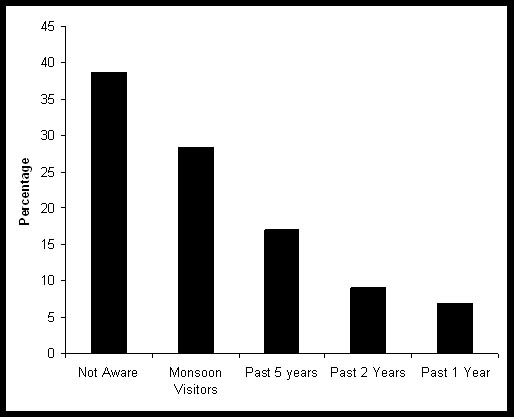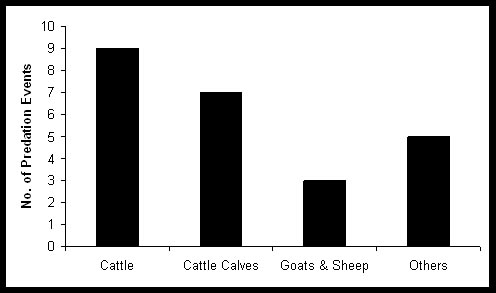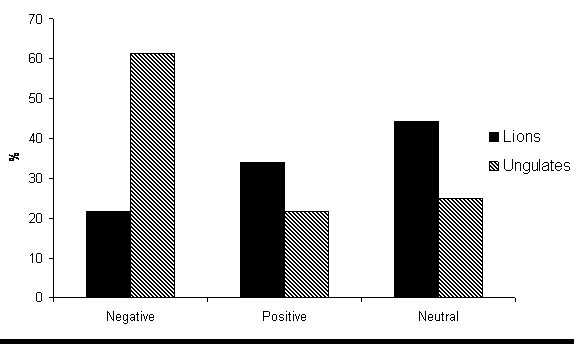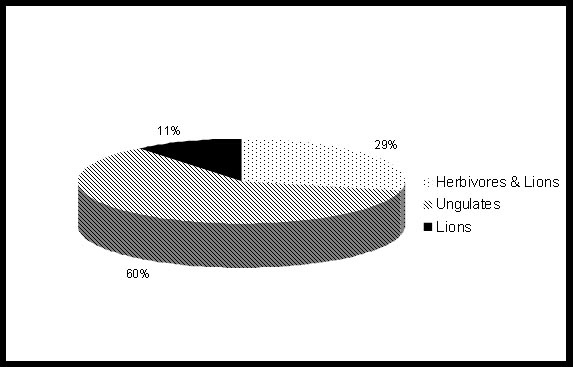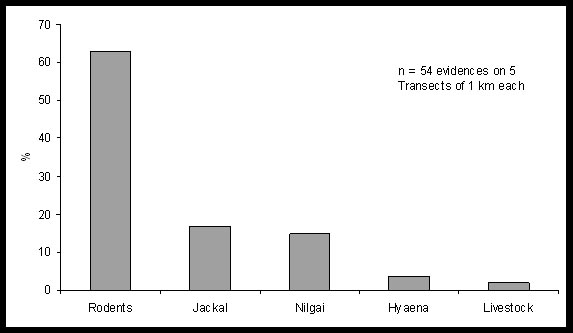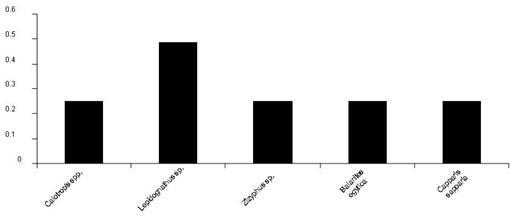Results and Inferences
|
The interview questionnaire surveys of 88 persons from 30 different villages in the impact zone reveled that lions had frequented the vicinity of 14 villages within the recent past (1 year) Fig. 7. Most persons interviewed and aware of lion presence (61%) reported that visits of lions to their areas were a recent phenomenon (since past 5 years), some reported lion visitation since the past 1 year. Many believed that lions visited primarily in the monsoon. Several persons interviewed were not aware of lion presence in their area (when in fact lions were frequent visitors) Fig. 8. Fig. 8. Responses of interviewees to lion presence in their area.
N = 88 persons from 30 villages Fourteen villages reported lion predation on livestock. There were 24 livestock predation events recorded within the past year. Cattle contributed maximum to the livestock killed by lions (Fig. 9). Amongst wild prey species, nilgai was reported as the most abundant. Fig. 9. Percentage of different livestock species predated by lions in the past one year within the impact zone.
n = 24 kills in past year The local economy primarily depended on dry farming and livestock herding. Most persons interviewed depended on making a living off the land and came in direct contact with the local wildlife. These persons had a positive attitude towards wildlife in general. There was a more complacent positive attitude to the presence of lions in comparison to nilgai which were considered to be agricultural pests (Fig. 10). The negative attitudes recorded towards lions were from livestock owners that had lost livestock to lion predation. Of the respondents that showed negative attitude towards wildlife, majority showed hostility towards nilgai and wild pigs (Fig. 11). Fig. 10. Attitudes of interviewees towards wildlife.
The data from transect survey in the close proximity of the proposed lease renewal area revealed that common wildlife species used these areas (Fig. 12). Fig. 12. Animal use of the areas in the close proximity of the proposed lease renewal area.
The sparce vegetation of this area was primarily constituted by the exotic Prosopis juliflora (98% of all plant species recorded) with a very few native plant species (Fig. 13). Fig. 13. Percent vegetation composition in and around the proposed lease renewal area as estimated by belt transects (besides P. juliflora which constituted 98% of the vegetation >2 ft in height).
Most of the areas were barren with no grass or palatable species. The grasses, where present, were dominated by salt tolerant, less palatable species like Aristida sp. Making the area less productive for supporting ungulate (domestic or wild) populations. Inferences 1) Though lions were found to be frequent visitors within the impact zone (10 km radius), this was a recent phenomenon (past 5 years) probably due to the increase within the source population of lions in the Gir Protected Area. The impact zone was unlikely to support a resident population of lions, it certainly does not have the potential for establishing a long term viable lion population. 2) The local population currently did not perceive the lion as a threat, this was likely due to the transient nature of the lions, their extreme low density, and only occasional predation on domestic livestock. Since the area is inhabited by humans with no substantial size patches of forests (or other cover) and no sizable populations of wild prey, the area has low potential even for the future establishment of a resident lion population. 3) The proposed lease renewal area was bounded on one side by salt marshes (see figure 1, satellite image) – a habitat unsuitable for lions, towns, villages, and industrial establishments with heavy machinery and active mining projects abound in the impact zone. The major prey for lions in this area was livestock. Thus, even if lions were to take up residence in this area (an unlikely event), their existence would eventually be fraught with conflicts with local human interests. 4) The geographic location of the proposed renewal lease area is such that it does not lie in any current or potential movement corridor of lions or other wildlife. There are no established lion populations in the impact zone, nor does the area have the potential to support a viable resident population unless the current land use practices are substantially altered. This would involve stopping all other industrial, mining, activities, major restorative ecology and translocation of several villages. Since the impact zone is outside of any legally protected area (National Park or Sanctuary), such a change in land use patterns is unlikely. If in the future resources were available to expand the Gir Protected Area System, the Impact Zone of the proposed lease renewal would not feature in any order of priority for consideration to be included as a part of a protected area system. 5) The transect sampling results suggest that common wildlife species like jackals, nilgai, hyenas, and rodents use these areas. There are no critically endangered species populations that are at risk if the lease is renewed. In light of the above data and evidence, we do not envisage any major impacts on habitat of lions or other endangered wildlife within the area proposed for lease renewal. The success of conservation efforts for long term survival of lions and its prey species and the prospects of environmentally responsible mining require partnership between conservation community and extractive industries for harmonizing commitments and sharing responsibilities. The M/s NCCL must therefore make a firm commitment to undertake appropriate compensatory mitigation measures (outlined in the subsequent section of this report) to offset the biodiversity impacts of limestone mining. |
Last Updated: October 6, 2015


